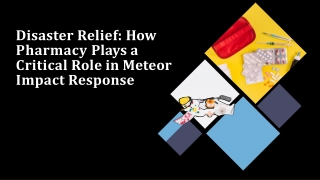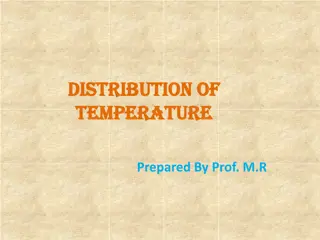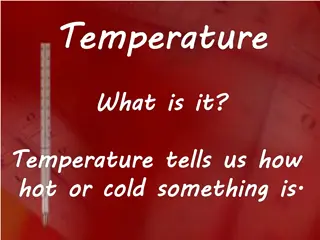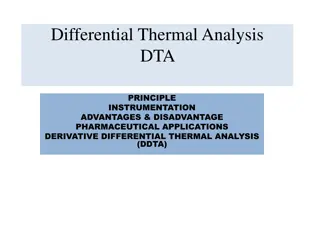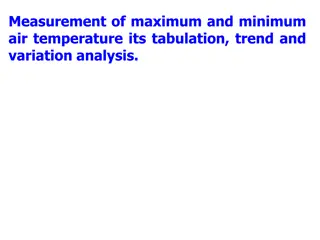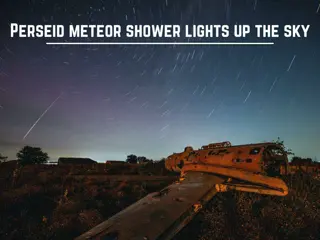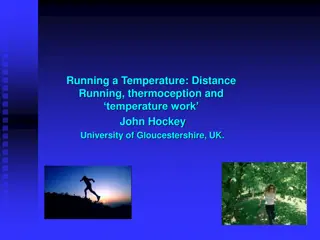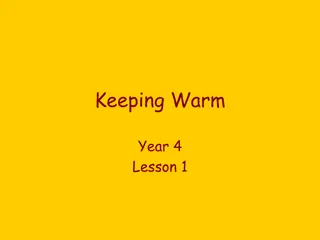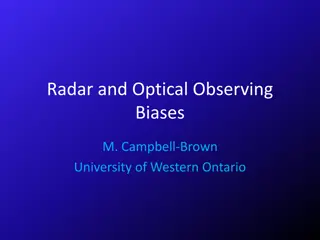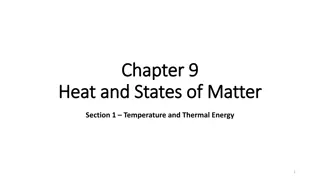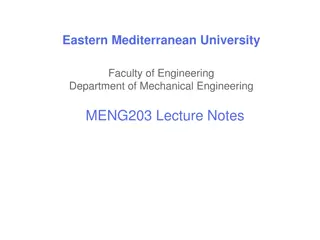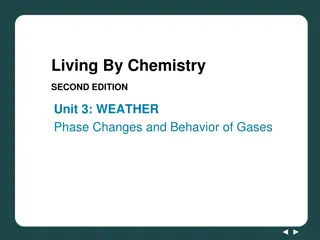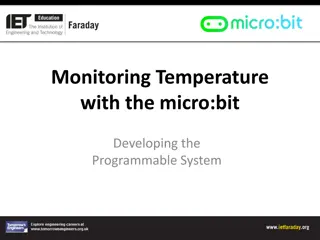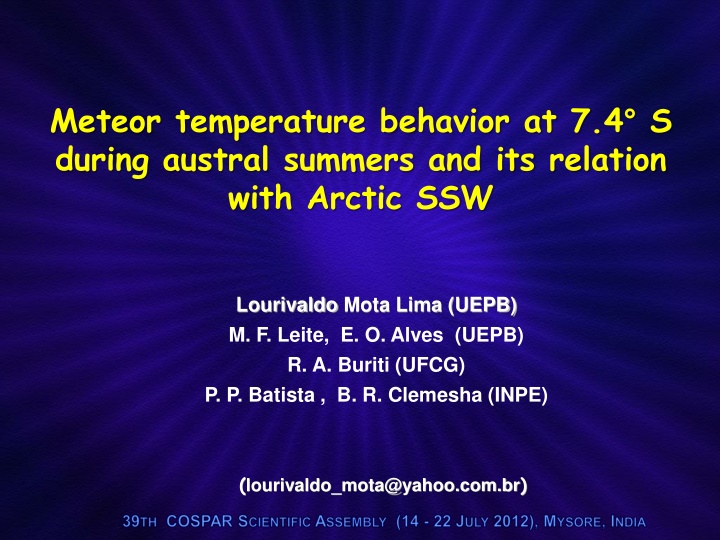
Meteor Temperature Behavior at 7.4 S during Austral Summers
Investigating the relationship between meteor temperature behavior at 7.4 S during austral summers and its connection with Arctic SSW events. The study explores how SSW events impact the dynamic and temperature regime in the MLT tropical regions, highlighting the correlation between stratospheric warming events and mesospheric cooling. Various techniques are employed to estimate MLT temperatures, including OH* rotational temperature measurements and sodium atom resonance scattering. The occurrence of Sudden Stratospheric Warming (SSW) events is examined, noting the significant increase in high latitude/polar temperatures below the 10 hPa level. Data from SKiYMET all-sky VHF radar in northeast Brazil is utilized to analyze temperature, winds, and NCEP data during austral summers from 2004-2009.
Uploaded on | 2 Views
Download Presentation

Please find below an Image/Link to download the presentation.
The content on the website is provided AS IS for your information and personal use only. It may not be sold, licensed, or shared on other websites without obtaining consent from the author. If you encounter any issues during the download, it is possible that the publisher has removed the file from their server.
You are allowed to download the files provided on this website for personal or commercial use, subject to the condition that they are used lawfully. All files are the property of their respective owners.
The content on the website is provided AS IS for your information and personal use only. It may not be sold, licensed, or shared on other websites without obtaining consent from the author.
E N D
Presentation Transcript
Meteor temperature behavior at 7.4 S during austral summers and its relation with Arctic SSW Lourivaldo Mota Lima (UEPB) M. F. Leite, E. O. Alves (UEPB) R. A. Buriti (UFCG) P. P. Batista , B. R. Clemesha (INPE) (lourivaldo_mota@yahoo.com.br)
Introduction Possible links between SSW events and variations on the MLT tropical dynamic and temperature regime have been reported recently. Shepherd et al. (2007) observed that mesospheric cooling and stratospheric warming, in the tropical regions are correlated with stratospheric warming events at middle and high latitudes. A link between the MLT winds at 8.7 N and major SSW events has been showed by Sathishkumar et al. (2009), in which the response of MLT dynamics to different SSW events has been attributed to variability of gravity waves. Lima et al. (2012) have analyzed the tides, 2-day wave and local mean zonal wind variability in the equatorial MLT region during three austral summers and found that upper mesospheric dynamics at 7 S has been affected when a major SSW event has occurred.
Several techniques have been used to estimate the MLT temperatures from the ground Measurements of the Rotational Temperature of the hydroxyl airglow ( OH*) is the most used method, given the temperature at around 87 km. The molecular oxygen, O2b (0,1) band at 866 nm, is also suitable to derive its rotational temperature, which corresponds to a nominal height of 95 km. The 80-105 km height profile of the temperature has been taken using sodium atom resonance scattering from Lidar technique. Meteor trail ambipolar diffusion coefficient is dependent of the local atmospheric temperature and density, and has been also used to estimate the mesopause temperatures at ~90km.
Sudden Stratospheric Warming -SSW The SSW events are characterized by a significant increase of the high latitude/polar temperature below the 10 hPa level, which occurs rapidly in just a few days. The formation of this sort of event has been attributed to the growth of upward propagating transient planetary waves and their interaction with the zonal mean flow (Matsuno, 1971). When the increase of the mean temperature occurs at any stratospheric level in the wintertime hemisphere and does not lead to a mean zonal wind reversal at the 10 hPa level, the SSW is classified as a minor warming. However, if the latitudinal mean temperature increase poleward from 60 latitude (at 10 hPa or below) is accompanied by a wind reversal at 60 and 10 hPa, the SSW is classified as a major warming (e.g., Schoeberl, 1978; Andrews et al., 1987).
Temperature, winds and NCEP data The temperature and winds used in this study have been collected from a SKiYMET all-sky VHF radar at S o Jo o do Cariri in northeast Brazil region (7 S, 36 W). The zonal and meridional wind components were estimated using radial velocity, which is determined from the Doppler shift of the returned signal. In this work, the zonal and meridional winds were obtained during the austral summers of 2004-2005, 2005-2006, 2006-2007, 2007- 2008 and 2008-2009, in 1-hour time bins for atmospheric layer of 4 km thickness centered at 90 km. To examine the evolution of the SSW events, we have used the meteorological reanalysis data produced by the National Center for Environmental Prediction (NCEP)
Meteor Temperature measurements Hocking (1999) uses the log10(1/ ) and log10(P) dependence for demonstrated that slope (Sm) of the scatter plot of the height (z) versus log10(1/ ) is related to the mean temperature in the meteor peak altitude. In this method, the temperature at the peak of the meteor layer can be estimated from = Mg k + 2 log (e) T S TG 0 10 m were TG is the temperature gradient, M is the mean molecular mass, g is the acceleration due the gravity, k is the Boltzmann constant. The slope Sm can be found by calculating the best fit line from the graph height versus log10(1/ ). This technique does not depend on knowledge of the pressure. However, it does require the temperature gradient (TG). In this work we uses the temperature profile from (MSISE-90) at the latitude of 7 S to obtain the TG model.
Results (2004, Dec 2005, Mar) Cariri meteor temperature = February January ( = = ) ( ) = 208.56 187.18K 223.92K 11.36 K T T T 198.46 186.16K 224.60K = 11.32 K T T T = min min max max The hemisphere polar cap presents a behavior compatible with a minor SSW stratospheric parameters in the northern The Cariri mean zonal wind undergoes a sharp change to westward during the time interval from Jan/14 to Feb/07. The meridional diurnal tide shows a decreasing amplitude in the same time when the mean zonal wind change to westward and reaches maximum just when the mean zonal wind has recovered the initial condition. From the scatter plot of the data from Cariri meteor temperature at 90 km versus the NH stratospheric-polar temperatures at 10 hPa, it is possible to see a trend of positive correlation (Pearson correlation coefficient = 0.488).
Results (2005, Dec 2006, Mar) Cariri meteor temperature Janua = = ry February ( ) ( ) = = = 188.04 170.78K 199.07K = 8.02 K T 195.33 178.90K 208.79K 9.20 K T T T T T min min max max The NH stratosphere polar showed sudden warming with zonal mean temperature at 10 hPa reaching 235 K near January 23rd when the zonal mean flow reversed to westward, characterizing a major SSW event. The Cariri mean zonal wind, is westward from December/24th, showing a variation around January 24. The diurnal tide amplitudes estimated in the equatorial MLT region were larger than those usually observed in other periods. When a major SSW has occurred, there is a good correlation between the temperatures, in which the Pearson correlation coefficient ( 0.755) indicates a strong negative correlation between them.
Results (2006, Dec 2007, Mar) Cariri meteor temperature January February ( ) ( ) = = 192.35 177.11K 211.03K = 10.81 K T T T 193.70 174.81K 213.21K = 9.66 K T T T = = min min max max Before February 20th, the NH stratospheric polar fields showed characteristics compatible with minor SSW events. However, a short warming has been observed around February 24th. The Cariri mean zonal wind reverses to westward only in January 16th and returns to eastward after Jan/29. From Feb/04, the Cariri mean zonal wind again reverted to westward. The meridional diurnal tide showed amplifications after February 1st, with maximum values near 50 m/s. During the time interval from January 1st to February 20, 2007, it is possible to verify a moderate positive correlation (0.406) between the temperatures.
Results (2007, Dec 2008, Mar) Cariri meteor temperature Janua = = = ry February ( ) ( ) = 191.40 177.11K 210.32K 9.58 K T 198.13 183.41K 211.27K = 7.58 K T T T T T = = min min max max On February 23th, the meteor temperature decreases to 180 K when the HN stratospheric-polar mean temperature and mean zonal wind behavior configure a major SSW. The mean Cariri zonal wind reverts to westward on January 10th, reaching 38 m/s on Jan/24. During the major SSW the mean zonal wind over Cariri fall to 8 m/s. When the major SSW has occurred, the meridional DT amplitudes first diminishes sharply and increases following the variations in the stratospheric-polar mean zonal wind. The scatter plot of the temperatures for Jan 1st Feb 20th, indicates (RPearson=0.713) when the NH polar stratospheric fields did not display major SSW event. For time interval Feb 16-28, when a major SSW ocurr, the temperatures indicate a negative correlation (RPearson= 0.762). a positive correlation
Results (2008, Dec 2009, Mar) Cariri meteor temperature (21 3 1) January = = February ( ) ( ) = 187.30 180.36K 193.32K = 4.25 K T T T 196.70 186.88K 204.76K = 5.01 K T T T = min min max max The NH stratospheric fields showed a major SSW during the period. The Cariri mean zonal wind showed reversal to westward on Jan/24 and reached a value of 53 m/s on Feb/20. The diurnal tide amplitudes increased after wind reversals and the meridional component reached 75 m/s in early March. For time interval from January 23 to February 20, the scatter plot showed a good correlation between the temperatures, with Pearson correlation coefficient of 0.740.
Summary From the five SH austral summer intervals investigated it was possible to verify that the dynamics in the SH equatorial MLT showed distinct behavior during January-February 2006, February 2008 and 2009, when major SSW events were observed in the NH high latitude stratosphere. On these occasions, the behavior of the Cariri meteor temperature suggests a coupling with the arctic major SSW events. During years with major SSW events, negative correlations were observed between the Cariri meteor radar temperature and arctic stratospheric polar temperature, while on minor SSW events the correlations were weak and positive. The diurnal tide also has exhibited an anomalous behavior, in which the amplitudes for meridional component were stronger after the major SSW events. Here, the behavior of the Cariri meteor radar temperatures during major SSW events have been interpreted as being due to tidal variability triggered by overall enhancement and amplified wave activity.
Acknowledgements The authors gratefully acknowledge the financial assistance provided by the CNPq and PROPESQ/UEPB .

